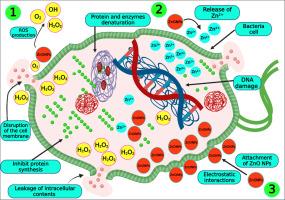Comprehensive review on zinc oxide nanoparticle production and the associated antibacterial mechanisms and therapeutic potential
引用次数: 0
Abstract
The antibacterial (AB) properties of zinc oxide nanoparticles (ZnONPs) have garnered significant global scientific interest, facilitated by advancements in nanotechnology that enable the production of particles within the nanometer scale. These ZnONPs have appealing antibacterial capabilities because of their increased specific surface area and reduced particle size, which increases particle surface reactivity. This review is about how antibacterial ZnONPs are. The scope encompasses testing methodologies, the impact of ultraviolet lighting, factors about ZnO particles such as size, concentration, shape, and defects, modifications to particle surfaces, and the determination of minimal inhibitory concentrations. The review concentrates on the formation of reactive oxygen species (ROS) such hydrogen peroxide (H2O2), hydroxyl radicals (OH-), and peroxide (O2–2), with an emphasis on bactericidal and bacteriostatic processes. ROS substantially affects a wide range of processes, including the consumption of harmful zinc ions in solution, the enhancement of membrane permeability, and the absorption of NPs and cell walls. This ultimately prevents cell growth and triggers cell death by reducing mitochondrial strength, causing leakage within cells, and activating oxidative stress genes. In addition, this review covers ZnO NPs in food packaging, highlighting their role as antimicrobial barriers against pathogens.

氧化锌纳米颗粒的制备及其抗菌机制和治疗潜力综述
氧化锌纳米粒子(ZnONPs)的抗菌(AB)特性已经引起了全球重大的科学兴趣,这得益于纳米技术的进步,使纳米级颗粒的生产成为可能。这些ZnONPs具有吸引人的抗菌能力,因为它们增加了比表面积,减小了粒径,从而增加了颗粒的表面反应性。本文就抗菌ZnONPs的作用进行综述。范围包括测试方法,紫外线照明的影响,氧化锌颗粒的因素,如尺寸,浓度,形状和缺陷,颗粒表面的修饰,以及最小抑制浓度的测定。本文综述了活性氧(ROS)如过氧化氢(H2O2)、羟基自由基(OH-)和过氧化氢(O2-2)的形成,重点介绍了杀菌和抑菌过程。活性氧实质上影响了广泛的过程,包括溶液中有害锌离子的消耗、膜通透性的增强以及NPs和细胞壁的吸收。这最终会通过降低线粒体强度、导致细胞内渗漏和激活氧化应激基因来阻止细胞生长并引发细胞死亡。此外,本文还综述了食品包装中的氧化锌NPs,重点介绍了它们作为抗病原体的抗菌屏障的作用。
本文章由计算机程序翻译,如有差异,请以英文原文为准。
求助全文
约1分钟内获得全文
求助全文

 求助内容:
求助内容: 应助结果提醒方式:
应助结果提醒方式:


